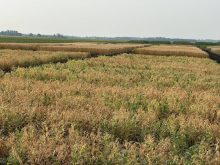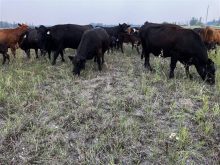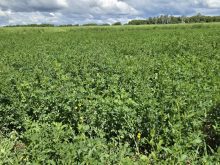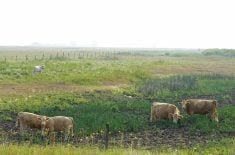Farmers thinking that this year’s rains might wash away the salinity problems they faced during last year’s drought need to think again. Marla Riekman, a soil management specialist with Manitoba Agriculture, says that while it might seem counterintuitive, as things dry out in wet years like this, salinity tends to get worse.
“With salinity, we think about it being a water problem, not a salt problem,” Riekman said. “When water comes to the surface, whether it’s increasing the water table because of high periods of precipitation, or whether it’s this kind of overland flooding… when that water is connected to the surface, the salts that are deeper down, because they’re mobile with water, can move up as well.
“What’s happening is that you’re feeding a water table and that water table is coming up closer to the surface,” she said.
Why it matters: Drought has led to an increase in salinity problems over the last few dry years. This year, it’s excess water that’s the problem.
It has to do with the mechanics of the hydrology beneath the ground. Those mechanics can draw salts up from deep in the soil that have leached down over the years. As those potholes later dry up, salts remain in place even as water recedes. “If we get a little bit drier now and we don’t have a lot of precipitation, there’s nothing to wash those salts down so they can stay on that soil surface,” Riekman said.
It’s the same mechanics that caused the salinity issues during last year’s drought. Salts were drawn up to the surface as surface evaporation caused moisture deeper down to rise, bringing the salts with it. “That’s just how salinity works,” Riekman said. “If the water comes up, salts will come up. If the water goes down, the salts will go down.”
More rain will be needed later in the season to wash salts down, but with the province’s waterlogged soil, more rain now would only feed into the problem of a rising water table.
So, what does all this mean for farmers?
In perhaps the most obvious piece of advice, saline-sensitive crops like corn or soybeans should be avoided on fields that farmers know as usual suspects for salinity problems.
If farmers find themselves in a situation where they are unable to get a crop in due to wet soils, it’s still important to plant something, Riekman also stressed.
“The better we can use up water, drop that water table down, and try to get that water out of the ground, the better off we are for allowing that leaching to start happening when the precipitation does fall,” she said. “If it’s not an annual crop, maybe (plant) a cover crop that’s grown for the purpose of de-watering in the field, trying to suck up water.”
This, she added, is where her oft-repeated message of salinity being a water problem kicks in. “Don’t get too hung up on the salt part; get hung up on the water part,” she said. “Manage the water so you have water.”
Canola producers may also want to consider salinity when it comes to their application decisions on sulphur, despite the nutrient’s notorious variability in soil test results.
Soil experts have noted the risk of salinity levels skewing soil nutrient tests.
“If there happens to be some salinity in the field that was inadvertently sampled at the same time as you’re sampling the field to get a fertilizer recommendation, the numbers can be many times higher in that saline area because sulphate salts are contributing to the content,” Manitoba Agriculture soil fertility specialist John Heard said.
“Our recommendations are that if you’re growing a highly responsive crop, like canola, you can just ignore the sulphur soil tests and apply an insurance level, because it is so critical to the growth of the crop,” he added.
For other, less responsive crops, there is less concern. “As long as you’re fertilizing canola in the location every two or three years, then that sulphur is recycled in the residue and the other crops can generally get nutrition that way,” Heard said.
















